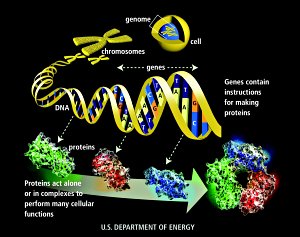For a long time now scientists have realized that this old idea was inadequate to explain how our DNA works and who we are. For example, when we learned that humans and the lowly worm C. elegans have around the same number of genes, we knew that (hopefully) there was more to our DNA than genes.
We're also beginning to learn that RNA is much more than a passive carrier of the information in DNA. For example, there are lots of small RNAs (called microRNAs) that affect how genes work.
And there is lots of other evidence that shows that the old ideas were just too tidy to explain our DNA. But now, through a project called ENCODE, we have a slew of new data that shows just how wonderfully complex our DNA is... and how little we really understand it.
ENCODE (ENCyclopedia Of DNA Elements) sets out to determine which DNA is involved in telling our cells how and when to read a gene. Last week scientists from lots of research groups including UC Santa Cruz and Stanford University published a paper based on the work they did in the pilot ENCODE project. (It is a pilot project because it only looks at 1% of the human genome.)
They threw every tool they had at around 30 million base pairs of the human genome and the data they generated shows that the central dogma is woefully inadequate to explain how our DNA works. Genomic biology is in the midst of one of those exciting changes that academics like to call a paradigm shift.
So what did they learn? I can't go into it all-- over 300 scientists in 10 different countries can sure generate a lot of data! But I'll go over one bit that I found interesting (you can also find out more here).
It looks like a lot more than the 1-2% of our DNA that is made up of genes gets transcribed into RNA. The researchers found that lots of DNA gets turned into RNA that doesn't get translated into a protein. In other words, lots of RNA for RNA's sake.
In fact, most of the DNA they looked at was transcribed into RNA in one way or another. Some of this was discrete pieces of RNA doing who knows what. And some of it just looks like the RNA kept getting made after the transcribing machinery made it to the end of the gene.
This paints a totally different picture of our DNA than we had before. We can't really think about our DNA as a wasteland with an occasional gene here and there anymore.
All DNA is made into RNA and most of it is probably done with good reason. Though scientists don't know why this is happening or what it means, they're eager to find out.
 Dr. Barry Starr is a Geneticist-in-Residence at The Tech Museum of Innovation in San Jose, CA.
Dr. Barry Starr is a Geneticist-in-Residence at The Tech Museum of Innovation in San Jose, CA.
 Our DNA is more than its genes. Credit: Genome Management
Our DNA is more than its genes. Credit: Genome Management